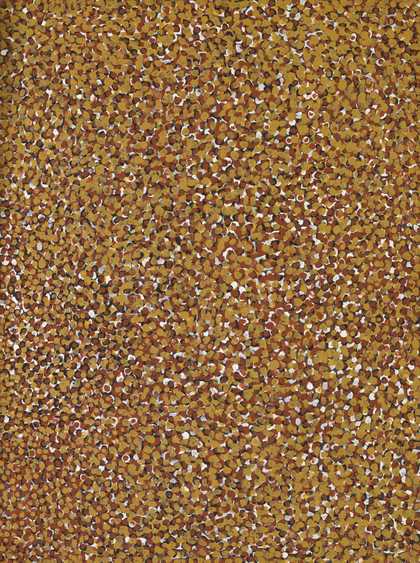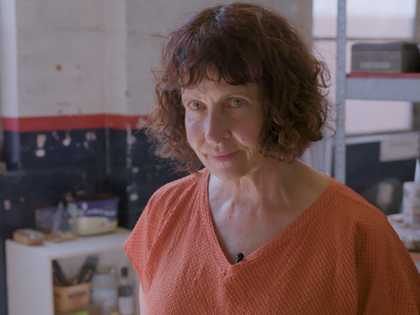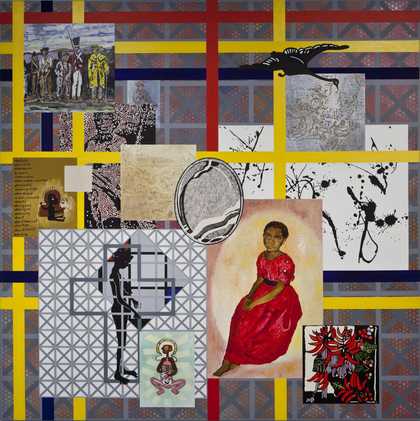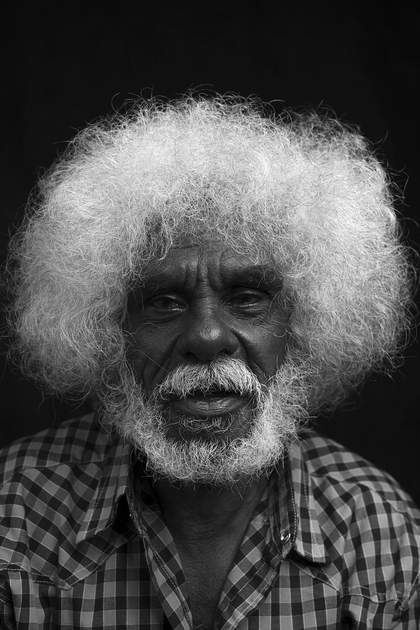
John Mawurndjul, Maningrida 2018, photograph: Rhett Hammerton
1. He is a leading contemporary Australian artist
John Mawurndjul was born in 1952 in the freshwater country of Kubukkan near Marrkolidjban, Australia. This is home to the Kurulk clan, part of the Kuninjku people.
He was tutored in painting by his older brother Jimmy Njiminjuma and uncle Peter Marralwanga. Through this tuition, he learned how to use rarrk, a cross hatching method, unique to Aboriginal people from the north of Australia.
First painting on small barks, Mawurndjul captured the attention of art critics when he began producing larger pieces.
Mawurndjul has had a major influence on the contemporary Australian art movement. His work has featured at exhibitions all over the world. In 2010, he became a Member of the Order of Australia 'for service to the preservation of Indigenous culture as the foremost exponent of the rarrk visual art style'.
2. He is ‘the old and the new’
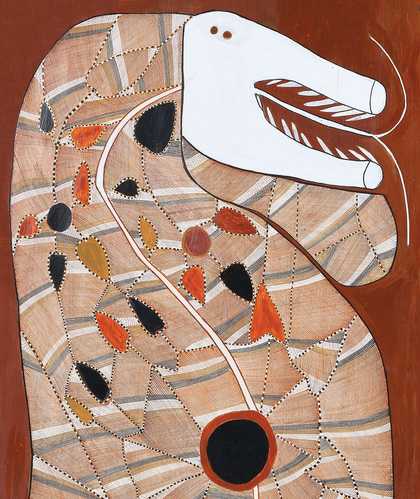
John Mawurndjul Ngalyod (detail), 2012, earth pigments on Stringybark (Eucalyptus tetrodonta), Museum of Contemporary Art, purchased with funds provided by the MCA Foundation, 2015 © John Mawurndjul / Copyright Agency, 2021, photograph: Jessica Maurer
He is the Djunkay of his country, a cultural manager and knowledge-keeper for the Kurulk clan. Mawurndjul pays tribute to other Kuninjku artists that came before him, like the traditional rock artists who painted and carved stories on rock for the generations that would come after them. He treasures the history of his ancestors and recognises the importance of sharing old traditions.
He also sees the value in creating a path for the new generation and mentors a whole school of new artists, including his wife, Kay Lindjuwanga, and daughter, Anna Wurrkidj. Mawurndjul’s art provides audiences with a gateway to understand the significance of particular sites in Australia.

John Mawurndjul Mankerrnge la mankare, the old and the new still from video filmed in western Arnhem Land Northern Territory in July 2016 and July 2017, produced by the MCA Digital Media department, in collaboration with the artist and Dr Murray Garde.
3. His work deals with themes of spirituality and mythology
I call that ancestral woman my aunt. That place is associated with the duwa moiety. The bones of the people who once lived there still remain at that place. When we go there today we can see that Buluwana is still standing there as a rock forever.
John Mawurndjul
Mawurndjul’s artworks depict sacred sites and Djang (physical places that are the focus of ancestral creator beings). One of his artworks Buluwana, Female Ancestor (1989) illustrates Buluwana, a woman from the Ngalkodjok group. It is believed that when she died, the body of Buluwana transformed into a standing stone which can still be seen today.
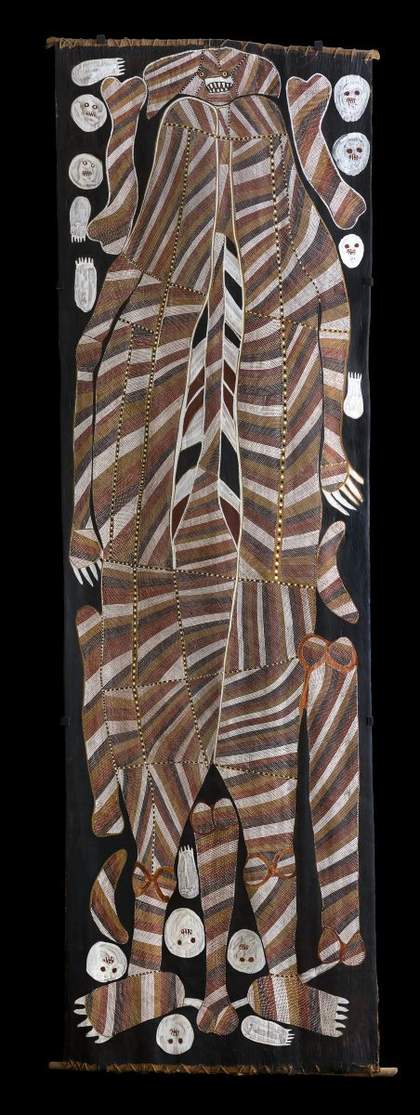
John Mawurndjul Buluwana, Female Ancestor 1989 Museum of Contemporary Art Australia, photograph Jessica Maurer © John Mawurndjul / Copyright Agency Collection: Tate and the Museum of Contemporary Art Australia, with support from the Qantas Foundation 2015, purchased 2020
4. He uses natural materials and unique methods

John Mawurndjul Kamarnbun bim, Making a work, still from video filmed in western Arnhem Land, Northern Territory in July 2016 and July 2017, produced by the MCA Digital Media department, in collaboration with the artist and Dr Murray Garde
Mawurndjul’s preferred base is bark. His father inspired him to paint on this material. Bark is not the only natural resource Mawurndjul uses in his work. He uses clay as paint, found in the earth at sacred places, like white ochre. This is said to be the faeces of Ngalyod (the Rainbow Serpent), a subject often painted in Mawurndjul’s artworks, considered one of the most powerful and widespread ancestral beings in Aboriginal creation stories. Other colours like red and yellow are sourced from ochres and black is sourced from charcoal.
Mawurndjul is known for his mastery of rarrk, a method which carries sacred knowledge. Rarrk is cross hatching which combines a mix of parallel and chevron lines that are finely painted on bark to produce an image. These lines, sometimes painted with a single hair, create texture and dimension. In Kuninjku, Kabimbebme is loosely translated as ‘colour pop’ or ‘paint jumping out’ which is the effect that can be seen in Mawurndjul’s work. It can sometimes take him three months to complete one bark painting due to the intricate detail.
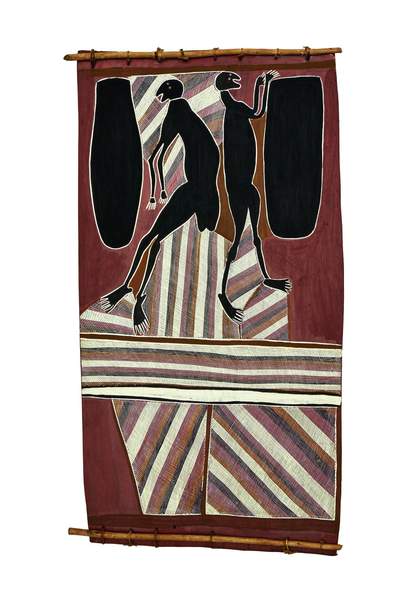
John Mawurndjul Ancestral Spirit Beings Collecting Honey 1985–87, earth pigments on Stringybark (Eucalyptus tetrodonta), Museum of Contemporary Art Australia and Maningrida Arts & Culture with financial assistance from the Aboriginal and Torres Strait Islander Board of the Australia Council, 1994 © John Mawurndjul / Copyright Agency, 2021 photograph: Jessica Maurer.
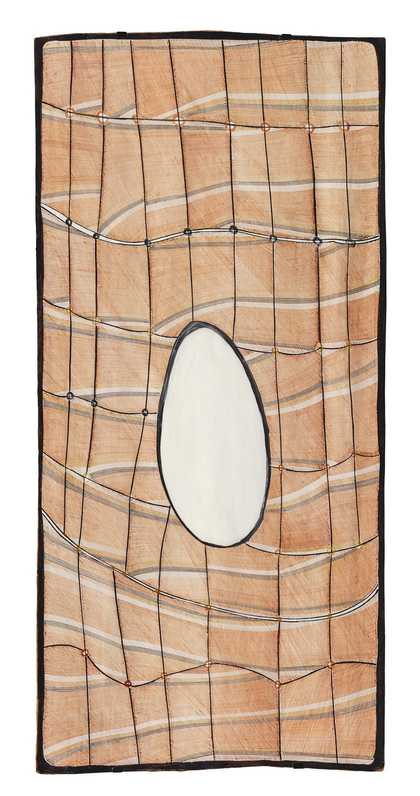
John Mawurndjul Milmilngkan 2007, earth pigments and on Stringybark (Eucalyptus tetrodonta), Art Gallery of South Australia, Adelaide, Gift of Susan Armitage through the Art Gallery of South Australia Foundation, 2016. Donated through the Australian Government’s Cultural Gifts Program © John Mawurndjul / Copyright Agency, 2021, photograph: Saul Steed
5. He takes inspiration from sacred places
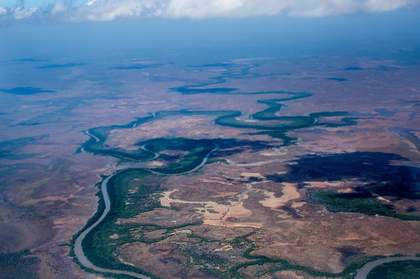
Aerial view of John Mawurndjul’s country, 2017, photograph: Jean-Pierre Chabrol
The Kurulk clan estate, which includes Mumeka, Dilebang and Milmilngkan, amongst many other special sites, is home to mimih (spirit beings), who live in the caves and crevices of the land. They cultivate the land, look after the animals and are often credited with passing on the songs and cultural stories of the dabborrabbolk, (the first people).
Mawurndjul says he often stands and looks across these sacred sites for inspiration before starting a new work. Once he has finished, he groups his artworks together according to kunred (places), keeping them connected no matter where they go.
His work has travelled all the way to New York, France, Germany, Japan and the United Kingdom for exhibitions throughout his career, and he is still making artwork today.
John Mawurndjul's artwork is on display at Tate Modern in A Year in Art: Australia 1992
Tate, The Museum of Contemporary Art Australia (MCA) and Qantas partnered in an International Joint Acquisition Programme for contemporary Australian art. John Mawurndjul Buluwana, Female Ancestor 1989, Tate and the Museum of Contemporary Art Australia, with support from the Qantas Foundation 2015, purchased 2020.

